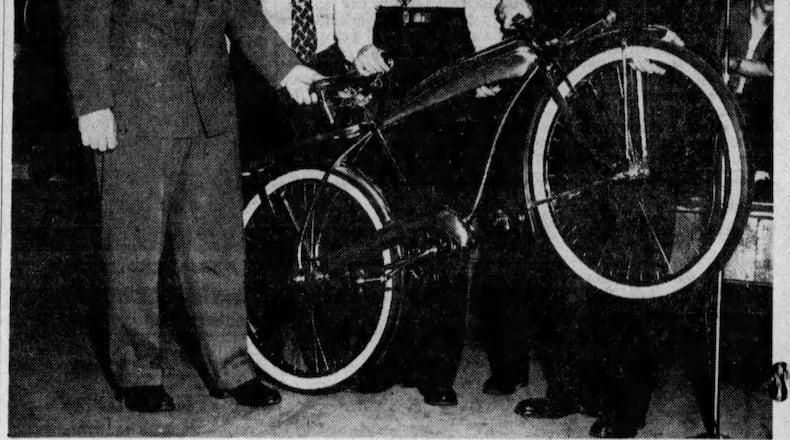Huffy bikes are still around today, and things have changed a lot since their early days. Here are some of the big moments in Huffy history.
George P. Huffman
Huffy bicycles take their name from the Huffman family. It all started with George P. Huffman, who was born in Dayton in 1862.
In his early life he studied law while working at the law office of Gunckel & Rowe, worked as a messenger for Third National Bank and also dealt in real estate.
Huffman didn’t waste much time in becoming a prolific businessman.
In 1887, he became president of the Kratochwill Milling Company. While still head of the Milling Company, he became head of the National Improvement Company and president of the Davis Sewing Machine Company.
He then rose to president of Huffman Publishing Company and of the Miami Valley Elevator Company.
In addition, he became vice-president of the Crume & Sefton Manufacturing Company, treasurer of the Cooper Hydraulic Company and a director in the Third National Bank.
He was also a director of The Homestead Aid Association, the Consolidated Coal and Coke Company of Cincinnati and the YMCA, of which he also spent one term as president.
Huffman died from complications of Bright’s Disease (kidney disease) Dec. 31, 1897 at the young age of 35.
‘Dayton’ bicycles all over the world
The Davis Sewing Machine Company started making the “Dayton” model of bicycle in 1892. It weighed 18 pounds.
by 1897, the company announced that 26,000 “Daytons” had been sold in the two previous years.
It was reported in the Dayton Herald that the Czar of Russia and the Crown Prince of Italy rode “Daytons.”
Huffman Manufacturing Company
In 1922, more than 600,000 bicycles were sold in the United States, and the industry was booming.
That same year, George’s son, Horace M. Huffman, and relative John M. Huffman formed Huffman Manufacturing Co. and opened a factory employing 100 to to manufacture “high-grade bicycles.”
A new line of bicycles with four models were put on the market — The Huffman “Flyer,” “Fleetwood,” “Federal,” and the “Radio.”
In 1933, Huffman Manufacturing was only making about 15 to 20 bicycles a day. By 1939, the company was making 600 a day, ranking it as the fourth-largest bicycle maker in the country.
World War II
Huffman Manufacturing was one of only two companies that were allowed to continue producing bicycles during World War II. Half of the bicycles used by the armed forces were made by Huffman.
The wartime “civilian transport model” was a stripped-down version that consisted of little more than two wheels, a brake, fender, frame, seat, pedals, light-weight tires and no chain guard.
After the war bike production doubled. Employment went from 385 to between 800 and 1,000 workers within a year.
Even though there was still some supply issues, the company was back to producing a “balloon” style bike. One that was complete with headlights, chain guards, stands, balloon tires, double-bar frames and “plenty of style.” All men’s bikes were painted maroon, and the women’s bikes were blue.
One millionth bicycle
The one-millionth bicycle manufactured by Huffman Manufacturing rolled off the assembly line on May 13, 1947. It had a chrome frame plated with 14-karat gold.
A brief ceremony was held at he plant. The bike had started on the assembly line at 5 p.m. and was finished by 5:07 p.m.
In 1947, the plant employed 700 people and was turning out 1,500 bicycles a day.
The special bicycle was to be put on display at the Third National Bank in Dayton for about a month before being shipped to the Henry Ford Museum of American Innovation in Dearborn, Michigan.
The bike is now on loan to Dayton History and can be seen at the museum at Carillon Park.
Huffy’s 30 millionth bike made it into the Smithsonian Institution in 1979.
Training wheels
Huffman Manufacturing started making “convertible bikes” in 1949. These were four-wheel bikes for children learning how to ride, and were the first bicycles made with what we now call training wheels. At the time they were described as “detachable outrigger wheels.”
In 1953, these bikes were also the first to be branded as “Huffy” bikes.
British invasion
In 1954, Huffman Manufacturing Co. signed a deal with British company Raleigh Industries to sell English-style light-weight Raleigh bicycles under the Huffy name. They would be branded as Huffy Sportsman bikes.
Expansion in the 1960s
During the 1960s, sales and earnings more than doubled, and continued growth was expected.
The Huffman Manufacturing Co. had a plant in Celina, where the bulk of the company’s bicycles were being produced. The Celina plant had about 650 employees.
In 1968, it expanded the plant by 375,000 square feet, for a new total of 610,000 square feet.
Richmond expansion
Due to an unprecedented demand for bikes, Huffman Manufacturing announced in 1971 that it would start making bicycles at its Richmond, Indiana plant. Previously, the plant was exclusively used for making outdoor power equipment.
By then, Huffman Manufacturing also had a small plant in Azusa, California.
Huffy quits Celina
The Huffy Corp. stunned its Celina workforce in 1998 by announcing it would shut down the world’s largest bicycle plant. The move left 1,000 people jobless. The plant was Celina’s largest employer.
“Only a handful” of workers were moved to Huffy’s bike plant in Farmington, Missouri. The Farmington plant was opened in 1994 and was non-union.
The company’s plan was to import bikes from Asia and Mexico to cover lost production. The Celina plant was making 1.6 million bikes annually.
Huffy at Carillon Park
Dayton is known for bicycling innovation and interesting bits of history are on display close to home.
Dozens of rare and antique bicycles are on display in the Dayton Cyclery building at Carillon Historical Park.
The collection has an emphasis on the Miami Valley’s role in bicycle evolution. By the mid 20th century, Dayton’s Huffy Corp. supplied more bicycles than any region in the world, Kress said.
Numerous Huffy bikes, including a gold-plated bike produced by the Huffman Manufacturing Company, can be seen at the park.
The golden bike, the one millionth produced by the company on May 13, 1947, is made with a chrome frame plated with 14-karat gold.
About the Author









